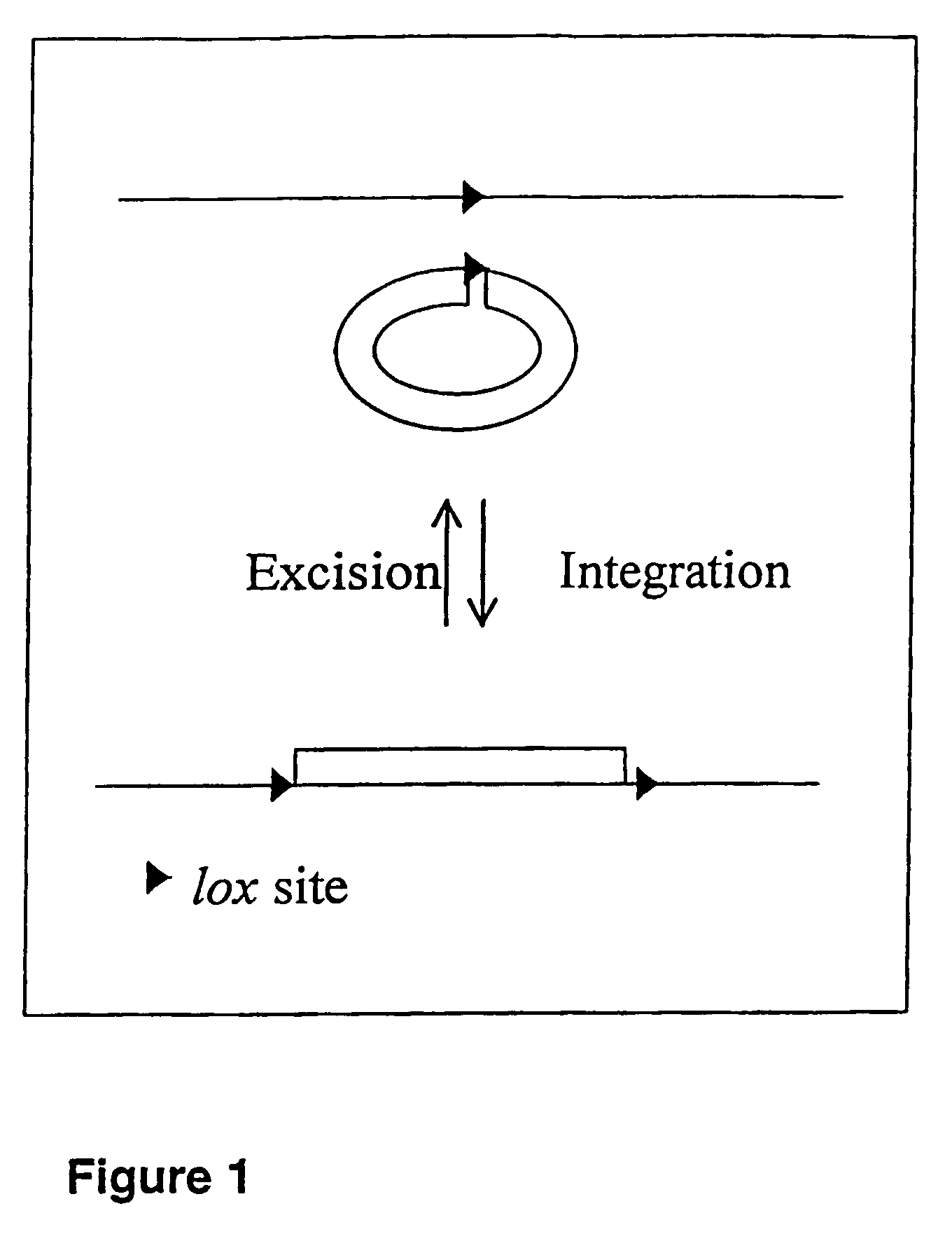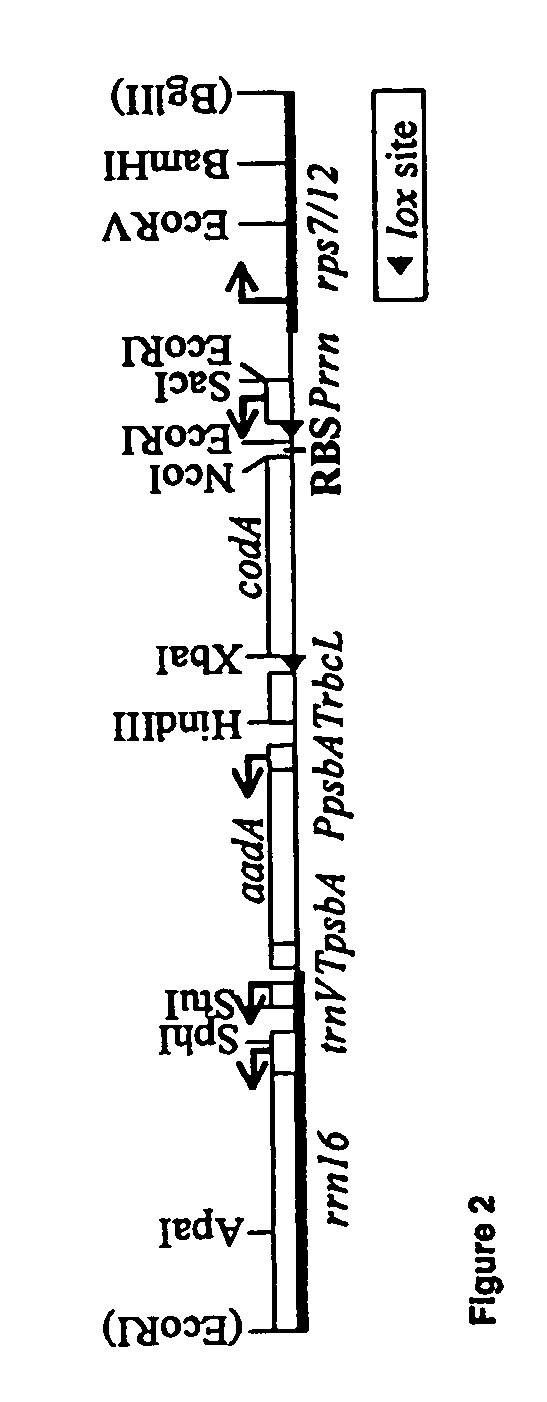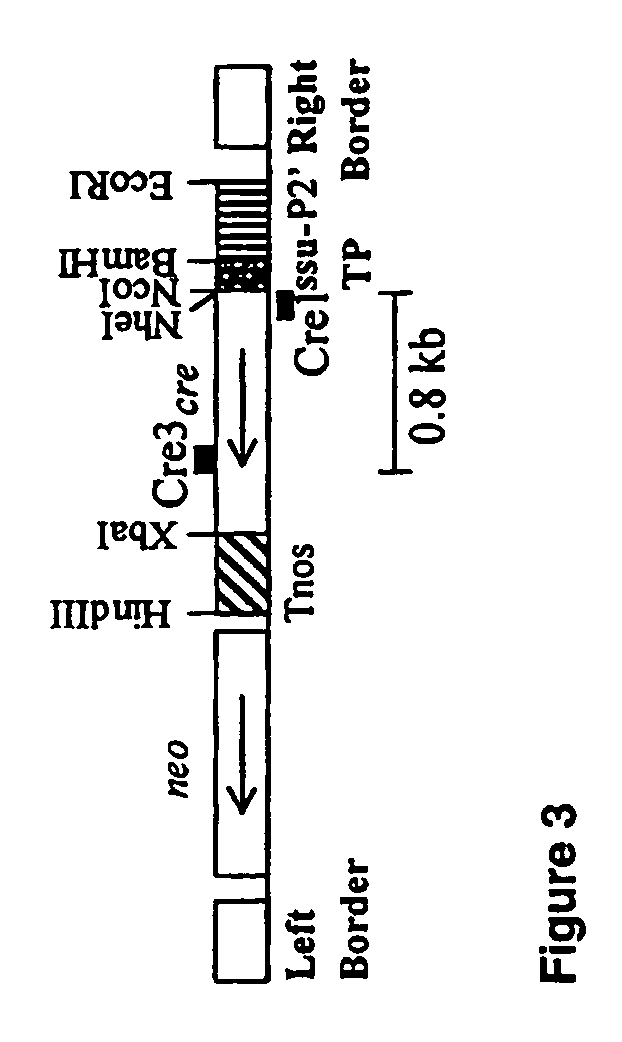Site-specific recombination system to manipulate the plastid genome of higher plants
a recombination system and plant technology, applied in the field of transgenic plants and molecular biology, can solve the problems of undesirable maintenance of the marker gene, relatively high potential for horizontal transfer of the plastid marker gene to microorganisms, and low efficiency of plastid marker gene expression
- Summary
- Abstract
- Description
- Claims
- Application Information
AI Technical Summary
Benefits of technology
Problems solved by technology
Method used
Image
Examples
example 1
Cre-Mediated Deletion of the Selectable Plastid Marker
[0063]Cre-mediated deletion of the selective plastid marker in the plastids of tobacco somatic cell is described in Example I. The selectable marker flanked by the lox sites is exemplified here by coda. However, it could be any other selectable and non-selectable marker gene, or any DNA sequence independent of information content flanked by lox sites in the plastid genome. Components of the test system are tobacco plants carrying a coda coding region flanked by lox sites (>codA>). A second component of the test system is a nuclear gene encoding a plastid targeted CRE-site specific recombinase. Deletion of a plastid encoded >codA> is achieved by introducing nuclear Cre into the nucleus of somatic (leaf) tobacco cells by Agrobacterium-mediated transformation. Alternatively, the nuclear encoded Cre gene may be introduced by fertilization with pollen of an appropriate activator-of-deletion strain. The nuclear Cre gene is subsequently...
example 2
Cr-Mediated Inversion of Plastid DNA Sequences
[0075]If the lox sites in bacteria are in an inverted orientation, CRE-mediated recombination results in an inversion of the intervening DNA. We have tested, whether the CRE-mediated inversion reaction also occurs in plastids of higher plants containing DNA sequences flanked by inverted lox sites. This was assessed using a kanamycin-resistance (>neoneoneoAgrobacterium-mediated transformation. A second approach is introduction of the nuclear-encoded Cre gene by fertilization with pollen of an appropriate activator-of-inversion strain. Additional approaches are to provide CRE-activity via the incorporation of chemically inducible promoter into the construct, or to transiently express CRE from a nuclear of chloroplast construct.
Materials and Methods for the Practice of Example 2
[0076]Plastid neo gene with inverted lox sites. The neo gene is contained in a SacI-HindIII fragment. The gene map is shown in FIG. 8. PrrnloxI (Seq. ID No. 1) is a ...
example 3
CRE-Mediated Deletion to Obtain Marker Free Transplastomic Plants and for High Level Expression of the Recombinant Proteins
[0085]Plastid loxP vectors in this section are described for CRE-mediated excision of selective markers in transplastomic plants. Since excision of sequences between directly oriented lox sites is very efficient, variants of the same vectors can be used for CRE-activated expression of recombinant proteins. A family of plastid vectors with suitably positioned lox sites is shown schematically in FIG. 14 through FIG. 17.
[0086]The map of the basic tobacco plastid lox deletion vector is shown in FIG. 14. It contains (a) two directly oriented lox sites separated by a unique BglII cloning site and (b) an adjacent polycloning site. These sequences (Seq. ID No. 11) are inserted into the ScaI site plastid repeat vector pPRV100 (U.S. Pat. No. 5,877,402; Zoubenko et al. 1994). Suitable marker genes (aadA, neo or kan, bar, glyphosate resistance, bromoxynil resistance) for in...
PUM
| Property | Measurement | Unit |
|---|---|---|
| Nucleic acid sequence | aaaaa | aaaaa |
| Sterile | aaaaa | aaaaa |
Abstract
Description
Claims
Application Information
 Login to View More
Login to View More - R&D
- Intellectual Property
- Life Sciences
- Materials
- Tech Scout
- Unparalleled Data Quality
- Higher Quality Content
- 60% Fewer Hallucinations
Browse by: Latest US Patents, China's latest patents, Technical Efficacy Thesaurus, Application Domain, Technology Topic, Popular Technical Reports.
© 2025 PatSnap. All rights reserved.Legal|Privacy policy|Modern Slavery Act Transparency Statement|Sitemap|About US| Contact US: help@patsnap.com



